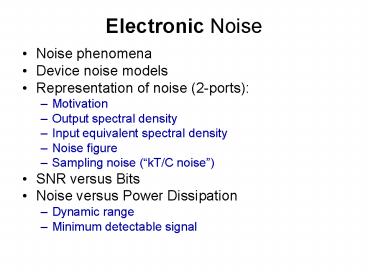Electronic Noise - PowerPoint PPT Presentation
Title:
Electronic Noise
Description:
Quantization error uniformly distributed between 1/2n ... If we include the flicker noise source, how would that affect the computation? ... – PowerPoint PPT presentation
Number of Views:1203
Avg rating:3.0/5.0
Title: Electronic Noise
1
Electronic Noise
- Noise phenomena
- Device noise models
- Representation of noise (2-ports)
- Motivation
- Output spectral density
- Input equivalent spectral density
- Noise figure
- Sampling noise (kT/C noise)
- SNR versus Bits
- Noise versus Power Dissipation
- Dynamic range
- Minimum detectable signal
2
Noise in Devices and Circuits
- Noise is any unwanted excitation of a circuit,
any input that is not an information-bearing
signal. - External noise Unintended coupling with other
parts of the physical world in principle, can be
virtually eliminated by careful design. - Intrinsic noise Unpredictable microscopic
events inherent in the device/circuit can be
reduced, but never eliminated. - Noise is especially important to consider when
designing low-power systems because the signal
levels (typically voltages or currents) are
small.
3
Noise vs random process variations
- random process variations
- Variations from one device to another
- For any device, it is fixed after fabrication
- Noise
- Unpredictable variations during operation
- Unknown after fabrication
- Remains unknown after measurement during
operation - May change with environment
4
Time domain description of noise
5
What is signal and what is noise?
6
Signal and noise power
7
Physical interpretation
If we apply a signal (or noise) as a voltage
source across a one Ohm resistor, the power
delivered by the source is equal to the signal
power. Signal power can be viewer as a measure
of normalized power.
power
8
Signal to noise ratio
SNR 0 dB when signal power noise power
Absolute noise level in dB w.r.t. 1 mW of signal
power
9
SNR in bits
- A sine wave with magnitude 1 has power 1/2.
- Quantize it into N2n equal levels between -1 and
1 (with step size 2/2n) - Quantization error uniformly distributed between
1/2n - Noise (quantization error) power 1/3 (1/2n)2
- Signal to noise ratio 1/2 1/3 (1/2n)2
1.5(1/2n)2 1.76 6.02n dB or n bits
10
-1ltClt1
C0 n1 and n2 uncorrelated C1 perfectly
correlated
11
Adding uncorrelated noises
Adding correlated noises
12
For independent noises
13
Frequency domain description of noise
Given n(t) stationary, its autocorrelation is
The power spectral density of n(t) is
For real signals, PSD is even. ? can use single
sided spectrum 2x positive side
? single sided PSD
14
Parsevals Theorem If
If x(t) stationary,
15
Interpretation of PSD
Pxf1 PSDx(f1)
PSDx(f)
16
(No Transcript)
17
(No Transcript)
18
Types of Noise
- man made
- Interference
- Supply noise
- Use shielding, careful layout, isolation,
- intrinsic noise
- Associated with current conduction
- fundamental thermal noise
- manufacturing process related
- flicker noise
19
Thermal Noise
- Due to thermal excitation of charge carriers in a
conductor. It has a white spectral density and is
proportional to absolute temperature, not
dependent on bias current. - Random fluctuations of v(t) or i(t)
- Independent of current flow
- Characterization
- Zero mean, Gaussian pdf
- Power spectral density constant or white up to
about 80THz
20
Thermal noise dominant in resisters
Example R 1k?, B 1MHz, 4µV rms or 4nA rms
21
HW
Equivalently, we can model a real resistor with
an ideal resistor in parallel with a current
noise source. What rms value should the current
source have? Show that when two resistors are
connected in series, we can model them as ideal
series resistors in series with a single noise
voltage source. Whats the rms value of the
voltage source? Show that two parallel resistors
can be modeled as two ideal parallel resistors in
parallel with a single noise current source.
Whats the rms value of the current source?
22
Noise in Diodes
- Shot noise dominant
- DC current is not continuous and smooth but
instead is a result of pulses of current caused
by the individual flow of carriers. - It depends on bias, can be modeled as a
- white noise source and typically larger than
thermal noise. - - Zero mean
- Gaussian pdf
- Power spectral density flat
- Proportional to current
- Dependent on temperature
23
Example ID 1mA, B 1MHz, 17nA rms
24
MOS Noise Model
25
- Flicker noise
- Kf,NMOS 6 times larger than Kf,PMOS
- Strongly process dependent
- -when referred to as drain current noise, it is
inversely proportional to L2
26
BJT Noise
27
Sampling Noise
- Commonly called kT/C noise
- Applications ADC, SC circuits,
R
von
C
Used
28
Filtering of noise
x(t)
y(t)
H(s)
H(f )2 H(s)sj2pf H(s)s-j2pf
29
Noise Calculations
- 1) Get small-signal model
- 2) Set all inputs 0 (linear superposition)
- 3) Pick output vo or io
- 4) For each noise source vx, or ix
- Calculate Hx(s) vo(s) / vx(s) (or io, ix)
- 5) Total noise at output is
- 6) Input Referred Noise Fictitious noise source
at input
30
Example CS Amplifier
Von(inRL inMOS)/goT
goT 1/RL sCL
RL
31
wo1/RLCL
32
Some integrals
33
HW
In the previous example, if the transistor is in
triode, how would the solution change?
HW
If we include the flicker noise source, how would
that affect the computation? What do you suggest
we should modify?
HW
In the example, if RL is replaced by a PMOS
transistor in saturation, how would the solution
change? Assume appropriate bias levels.

